Why Disaster Rehab Must Focus On Landless Dalit Farmers
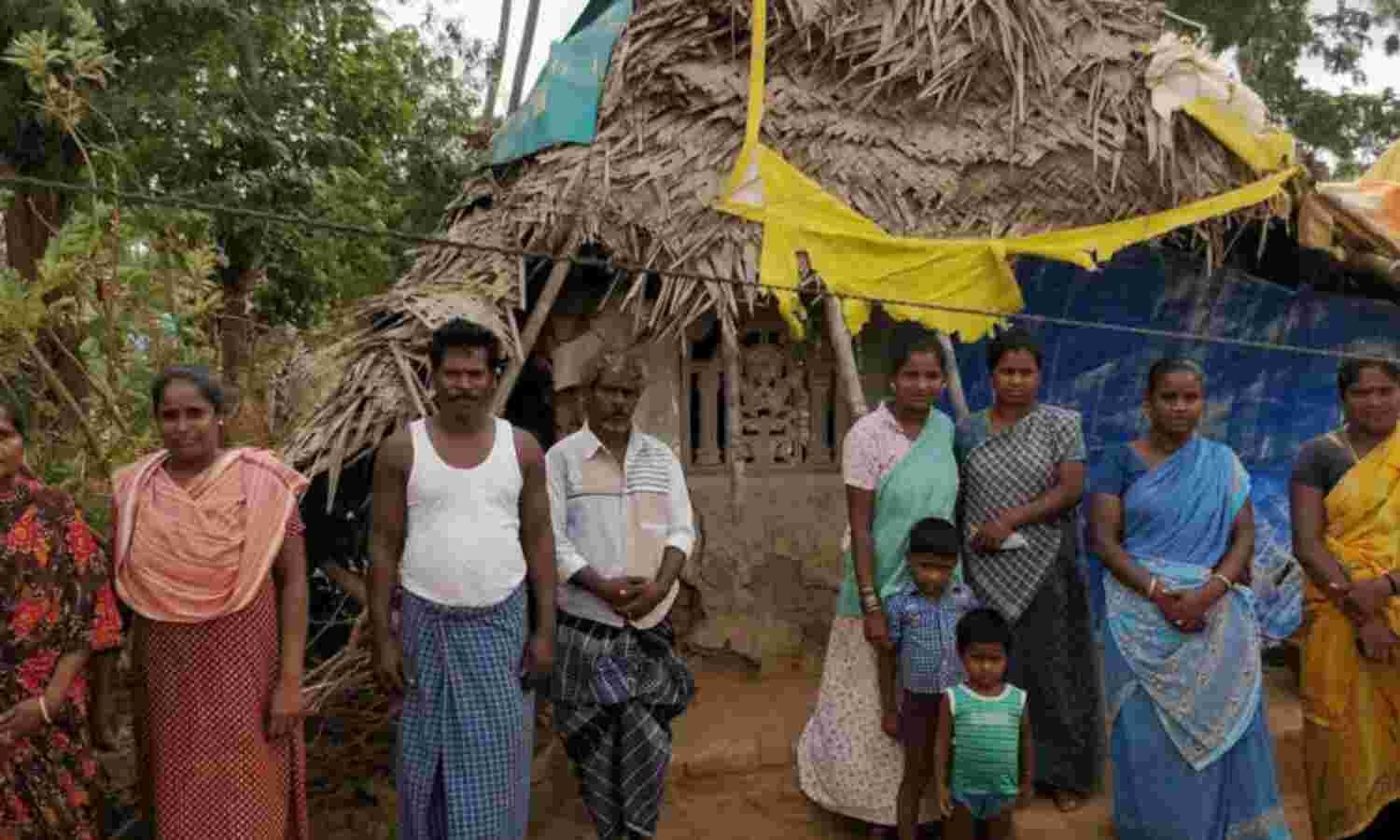
Thalainayar, Nagapattinam district: It has been 11 months since Cyclone Gaja devastated the coastal districts of Tamil Nadu. Rehabilitation programmes worth Rs 1,164 crore (around $161 million) are being unpacked across the state’s several affected districts. But Paneerselvam, a 45-year-old Dalit farm labourer in Thalainayar, a village in the southern district of Nagapattinam, has no hopes of a better future.
The home where three generations of Paneerselvam’s family had lived and the coconut trees he had raised on village common land were severely damaged by the cyclone. But despite his losses, the farm-worker has yet to benefit from any long-term government rehabilitation scheme because he is landless and a Dalit, “lowest” on the Hindu caste hierarchy. He is among the 200 million Dalits in India, nearly 16.6% of India’s population.
Landless Dalits, living on the margins of settlements, are hit hardest by natural disasters and are the last to get relief supplies which tend to be monopolised by upper and intermediary castes, as IndiaSpend reported in August 2019. In our investigations across Odisha and Tamil Nadu, which were affected by Cyclone Fani in May 2019 and Gaja in November 2018, we found that these marginalised communities are left behind in the subsequent rehabilitation programmes as well.
Disasters affect the poor disproportionately, as IndiaSpend reported in August 2019. With their homes, farmland, trees, livestock and all prospects of daily-wage work gone, the poor find themselves without any financial means to resume their lives once they return home from shelters.
Nearly 71% of Dalits work as farm labourers at the bottom of India’s agricultural economy, the 2011 Census showed. But they own only 9% of cultivable land, and nearly 61% of it is smaller than 2 hectares. They need rehabilitation assistance the most in the aftermath of a natural disaster but get its benefits the least because they have no resources they can lay claim to, we found.

“Most schemes target those who have some land,” said Tanamay Kumar Jena, a social worker with a Bhubaneshwar-based NGO, Centre for Youth and Social Development (CYSD). “Those who do not are voiceless in our system and it is extremely hard to get them benefits.”
Paneerselvam, for example, is not eligible for the government housing rehabilitation scheme for the disaster-affected. His hut, which was home to three generations of his family, was among the 130,000 houses wrecked by the 140-kmph storm. All that is left is a ramshackle structure with a half-finished wall and a tattered roof stitched together from tarpaulin and coconut fronds.
But Paneerselvam’s home is by the river and it violates regulations that disallow constructions within 50 m of the creeks and rivers. This makes him ineligible for government housing assistance. “The government wants to relocate us as we will not get the patta (registration) for our house,” he said.
It is not just housing, landless Dalits like Paneerselvam also get no help in finding a new source of livelihood or resuming their old work, as we explain later. He has had no steady work or income since the cyclone destroyed all the farms around his village.
“When farms are destroyed following a natural hazard, both land-owners and landless labourers are affected due to loss of plantation, poorly stored produce, work and associated income,” said Garima Jain from the Indian Institute for Human Settlements (IIHS). But while the landowning farmer is compensated for the loss of crops, landless farmers like Paneerselvam get no assistance.
Jain was part of a team that studied the impact of Cyclone Fani and found that people dependent on horticulture on commons land were deeply affected and for longer periods because trees take many years to grow back.
The trunks of damaged coconut palms that rise behind Paneerselvam’s hut are a common sight in cyclone-affected areas. His few coconut trees had provided a little extra income to supplement his meagre farm-hand’s wages, but those were uprooted by the storm too. “It will take another four years for the coconut palms to regrow,” Paneerselvam pointed out. Since this “farm” is not registered, he will not be compensated unlike land-owning farmers.
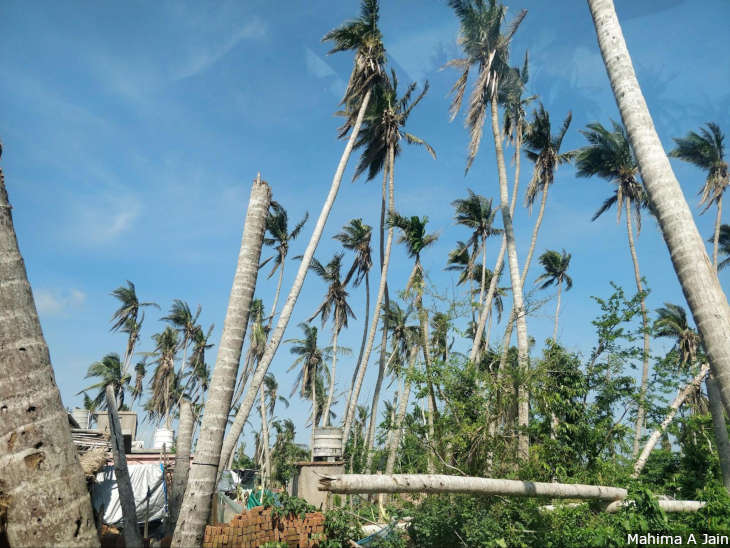
Coconut orchards destroyed by cyclones, such as these in Puri district, Odisha, take 4-5 years to recover and regrow. The damage to the agricultural economy caused by cyclones in Odisha and Tamil Nadu shows that landless Dalit farm workers find it toughest to get back on their feet in the months following a disaster.
This marginalisation of landless Dalits in the rehabilitation process has been called out repeatedly in reports on previous disasters such as the 2004 Indian Ocean tsunami and the Super Cyclone of 1999 that made landfall in Jagatsinghpur district of Odisha.
Not only are the poor and vulnerable classes more likely to suffer during a disaster but because they experience slow income growth, they also have a harder time recovering. Between 2 million and 50 million Indians may be pushed into poverty by 2030 for these reasons, according to a UN report on climate change and poverty, which warned of a “climate apartheid”.
No work, home, livestock
Dalit farmers in Odisha experienced a similar situation when Cyclone Fani made landfall in May 2019, destroying more than 500,000 homes. Dharanidhara Bhoi, 45, a farm labourer of Rebana Nuagaon in Puri district, was among those saved by timely evacuation. But he lost everything else.
Bhoi’s 200-sq ft one-room hut that housed his family and 16 goats was damaged. He does not own a TV, computer or motorcycle and the one mobile phone the family shared was damaged during the cyclone. A few kitchen vessels survived as did the stove and these now sit outside the hut, amidst debris and cow dung.
Over 43% of Dalit houses across India are either semi-permanent or temporary structures, a figure that rises to over 50% in rural areas, according to Census 2011 data. In rural India, only 0.5% of Dalits own a TV, computer/laptop, phone/mobile and vehicle. Around 22.6% of Dalit houses did not have any of the aforementioned assets. Nearly 48% of Dalits live in one-room dwellings, just like Bhoi and Paneerselvam.

Such structures are easily impacted during disasters, and in Odisha damage to houses was highest among tribes and Dalits at 98% and 95% respectively, according to a post-Fani assessment by CYSD.
“I lost everything... my children’s books, clothes, food,” Bhoi recalled. “I had 31 goats, 15 died in the cyclone,” Bhoi said. Livestock is critical for those living in extreme poverty because it helps them tide over unproductive farming seasons. Bhoi will not be compensated for their death as he was unable to navigate the complexities in registration of his livestock with the Animal Husbandry Department and obtaining government-issued death certificates required for compensation.
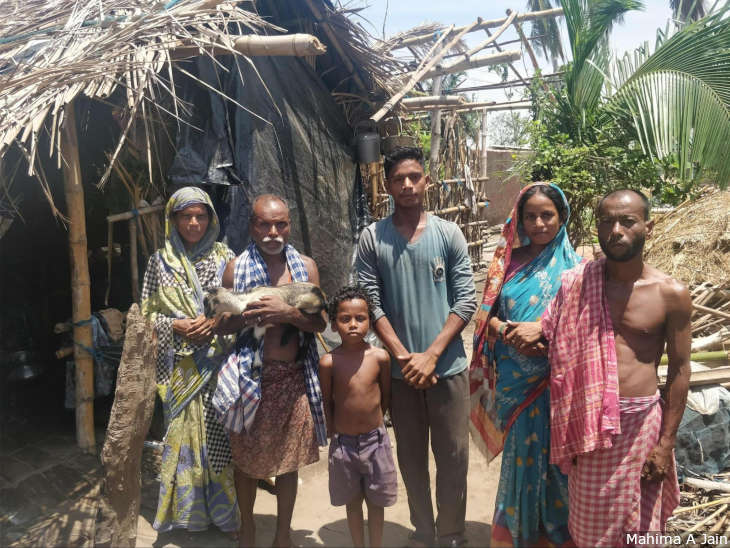
Dharanidhara Bhoi (second from left) with his family and neighbours in front of his hut in Rebana Nuagaon, Puri district, Odisha. They own no assets and rely on daily wage farm work, which is hard to come by in cyclone-affected areas. Rehabilitation schemes need to actively look at the needs of such groups and help them to “build back better”.
The agricultural sector endured 55% of the losses after Fani, according to an assessment published by the state government. More than 8.85 million livestock (cattle, small animals, poultry) perished, and 18.2 million hectares (ha) of crop area were affected. The damage from Gaja had been smaller--88,000 ha of crops, 60-80% of coconut trees, and 80,000 livestock.
Half-dead orchards, farmlands filled with sludge, lost livestock and increasing soil salinity due to storm surges are common across the areas affected by Fani and Gaja that IndiaSpend visited. Many villagers said that the cyclone’s lasting impact makes it difficult for them to find daily wage work for months at end.
The need for sustained rehab
Odisha has been recurrently hit by disasters for 20 years now, and some areas have been hit twice, the upcoming IIHS report, co-authored by Jain, notes. But because it is a poor state with deep-rooted socio-economic and physical vulnerabilities, it is still recovering from some of the earlier losses inflicted on its society, economy and environment, the report noted.
Pratima Sagar Das remembers the Super Cyclone of 1999. She was 25 then, and seven months pregnant with her third child. The tidal surge of 7-10 m had reached 20 km into the coastal village of Dhinkia where she lived with her parents. The cyclone killed 10,000 people, left over 20 million homeless, and destroyed 3 million semi-permanent houses.
“There were no buildings left in the village apart from the temple and one or two pucca (solid, permanent) houses,” said Das, now 45, and a resident of Govindpur, 7 km from Dhinkia. So life-changing was that cyclone that she named her son Pralay, meaning ‘disaster’.
Pratima has a small farm (less than 2 acre) and her husband works as a labourer in a nearby town. When Fani passed their village, the family was better prepared. There were some more concrete houses, including hers, and a relief shelter too.
“After the Super Cyclone, our motto was: Roof over our heads, water for the land, work for our hands, and right to information,” explained Akshay Kumar, farmer leader and founder of Navnirman Krushak Sangathan (NKS), a non-profit farmers’ movement started in 2000 for relief and rehabilitation post Super Cyclone. The collective has worked toward long-term recovery of farmers in cyclone-affected areas by focusing on all-round needs of farmers and labourers like Pratima, who is a member of the NKS.
“The conversation has to go beyond just relief and must include housing and livelihoods: Recovery should be part of the government agenda,” Kumar said. “Regardless of the great strides made in disaster management, proper rehabilitation and recovery (still) has a long way to go 20 years after the Super Cyclone.”
What marks disaster relief apart from rehabilitation?
“Disaster relief is a one-time job, it starts and has an end point,” said R Gopinath, senior scientist on food security at the M S Swaminathan Research Foundation (MSSRF). “Rehabilitation is continuous, it lasts for 2-3 years and it should be phased. It includes provision of sustainable income sources and resilient housing.”
The post-disaster phases of recovery, rehabilitation and reconstruction are identified as a critical opportunity to “build back better”, as per the UN’s Sendai Framework for Disaster Risk Reduction 2015-2030 to which India is a signatory. This implies integrating disaster risk reduction measures with the restoration of physical infrastructure and societal systems, and the revitalisation of livelihoods, economies and the environment.
As India ramps up its preparedness for disasters, climate change-related or otherwise, it has an opportunity to overhaul the system with practices such as intercropping, growing climate-resilient crops and deploying other adaptation measures, Gopinath explained. Constructing resilient houses in disaster-prone areas is also crucial, he added.
Currently, disaster relief and rehabilitation in India has two components: Immediate compensation for damage to life, property, livestock and livelihood, followed by targeted reconstruction and rehabilitation programmes focussing on resilient housing and sustainable livelihoods.
Rebuilding shattered homes
In the absence of a national-level housing programme for the disaster-hit, Odisha and Tamil Nadu co-opted central and state programmes--the Pradhan Mantri Awas Yojna (or PMAY, formerly Indira Awas Yojna) and Odisha’s Biju Pucca Ghar Yojana for example, into disaster rehabilitation.
Odisha seeks to build nearly 500,000 houses under PMAY for Fani-affected victims, and Tamil Nadu will build over 100,000 houses for Gaja victims under the same scheme.
Disaster rehabilitation schemes are currently drawing from existing rural development programmes and schemes, explained Gopinath. But there are few programmes that directly assist disaster-affected Dalits, who are often landless and assetless, as we mentioned earlier.
Homes owned by Dalits like Paneerselvam’s and Bhoi are mostly semi-permanent structures built on unregistered land. Tamil Nadu’s post-Gaja experience shows how such people can slip through the net at the implementation level.
Dalits have faced historical discrimination in their attempts to register their lands, and “land titles given to Dalits in land-redistribution programmes have not worked as the higher castes, who originally owned the land, never ceded control”, an IndiaSpend report noted in June 2019. In 13 Indian states, 92,000 Dalits are involved in 31 conflicts in their fight to claim land, according to Land Conflict Watch.
Tamil Nadu now plans to segregate houses on commons properties, temple and leased land, and river banks into “objectionable” and “unobjectionable” categories.
“We are in the process of buying lands which the landless have already occupied wherever possible,” explained M Pradeep Kumar, additional project director of Tamil Nadu government’s special project, the Gaja Cyclone Rehabilitation Reconstruction and Rejuvenation.
Those who live in properties on “unobjectionable” properties such as temple lands will get a registered piece of land for their houses, under this project, but those on “objectionable” land will have to be relocated to other places. It is common for such relocation attempts to be resisted, Kumar said.
Among the objectionable category are houses on or along water bodies, like Paneerselvam’s hut which is between a canal and the River Harishchandra. So while he was compensated for damage to his house, he will neither receive a registered house under the government’s scheme nor be compensated for the loss of coconut trees (approx Rs 1,500 per fallen tree) because these grew on commons land.
Tamil Nadu announced Rs 10,000 for kutcha (non permanent) houses, Rs 4,500 for semi-kutcha, and Rs 3,000 for partially damaged, old pucca (permanent) homes. Housing assistance for the disaster-affected in Odisha is higher--Rs 95,100 for fully damaged structures, Rs 5,200 for partially-damaged and Rs 3,200 for minor damages).
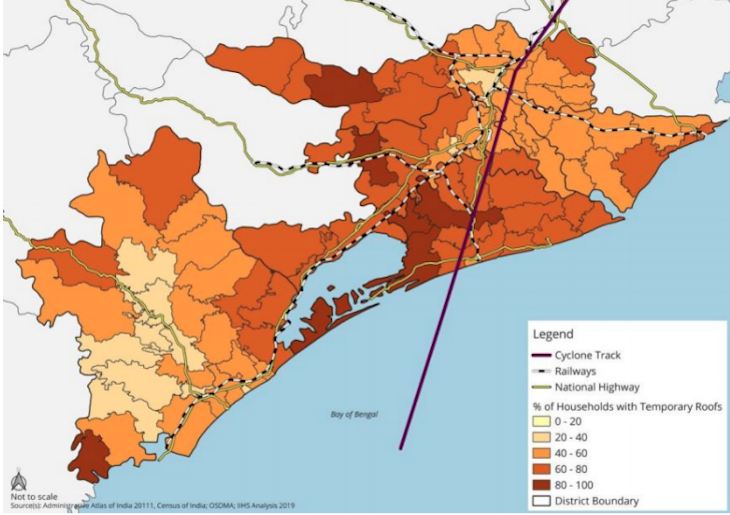
Source: A Road To Long-Term Recovery for Odisha, Indian Institute for Human Settlements.
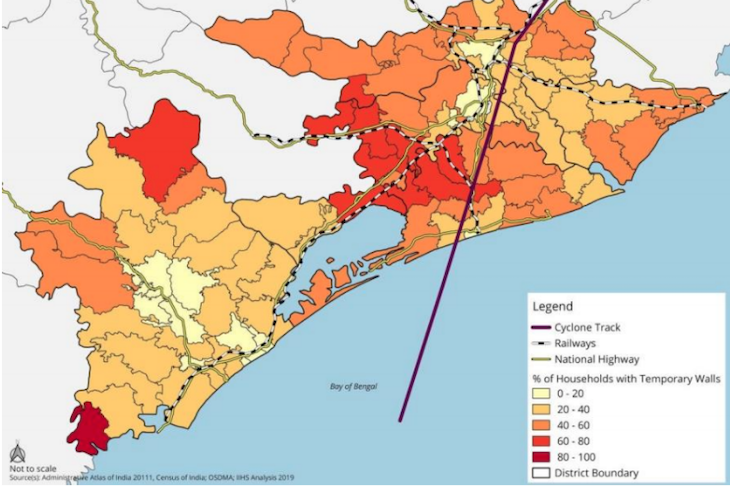
Source: A Road To Long-Term Recovery for Odisha, Indian Institute for Human Settlements.
Rehabilitation of livelihood
Another area of concern in rehabilitation, as we mentioned earlier, is livelihood.
In the absence of specific rehabilitation policies for landless labourers, India’s guaranteed rural employment scheme (under Mahatma Gandhi National Rural Employment Guarantee Act or MGNREGA) has been co-opted into the disaster response process in most states but the chances of the needy not getting the attention they deserve are high here too. The Dalits are mostly engaged in debris clearance and reconstruction activities after a disaster.
The uptake of MGNREGA among the disaster-affected was low, government sources in Odisha said. But in Tamil Nadu, where MGNREGA was immediately merged with disaster relief measures, there was an increase in applications post-cyclone.
The number of person days under MGNREGA in the country has increased in recent years--from 2.33 billion in 2016-17 to 2.55 billion in 2017-18. Drought-hit areas, assigned 50 additional days of work, and other areas hit by various disasters, showed an uptake in MGNREGA work across India.
“I am not eligible for that also,” said Paneerselvam, of MGNREGA work. Thalainayar’s status as a town panchayat city, an intermediate category between rural and urban areas, makes farm labourers like him ineligible for MGNREGA. Dalits make 35% of the town’s population, and many among them are daily wage labourers.
A drought had followed Cyclone Gaja in areas located at the tail-end of the Cauvery Delta, further squeezing farmer incomes. It is only in the upcoming agricultural season, nearly 10 months after the cyclone, that Paneerselvam can hope to find consistent farm work.
With more extreme climate events ahead, need for a plan
“We need to have area-specific, climate-friendly inclusive policies, that includes Dalits, landless people,” said Gopinath, co-author of a post-Gaja assessment report focussing on livelihood rehabilitation.
Currently, nearly 17% of all Indians (250 million), more than Brazil’s entire population, live 50 km from the coast. Of the country’s 7,500 km coastline, 5,700 km is prone to cyclones and tsunamis, with the east coast more vulnerable than the west. Globally, disaster-hit countries experienced direct economic losses valued at $2.9 trillion between 1998 and 2017, a 2018 UN Disaster Risk Reduction reported. Climate-related disasters were responsible for 77% of the total losses, a figure of $2.25 trillion. India’s total loss was valued at $79.5 billion.
India is likely to witness more intense cyclones, storm surges, tidal waves, saline water intrusion, sea level rise and other impacts of climate change in the coming years, according to the Intergovernmental Panel For Climate Change.
Between 1891 and 2006, 308 cyclones crossed the east coast, of which 103 were severe (Gaja at 140 kmph was “very severe”, and Fani at 260 kmph was “extremely severe”). The west coast witnessed weaker cyclonic activity; of 48 cyclones, 24 were severe.

Source: Temperature Rise and Trend of Cyclones over the Eastern Coastal Region of India, Journal of Earth Science and Climatic Change, ©2014 Mishra A

Source: Temperature Rise and Trend of Cyclones over the Eastern Coastal Region of India, Journal of Earth Science and Climatic Change, ©2014 Mishra A
“We know how much land and livestock is affected after a disaster, but we have no technical estimation of how it translates to loss of livelihood over time,” Gopinath said. For the agricultural sector, this can be calculated at the end of the farming season or during the mid-term. An estimation of opportunities, livelihood lost, alternative employment, skill gaps, and skill sets required for the future are areas where non-government organisations can help the government design more effective rehabilitation schemes, he said.
Such policies should include vulnerable and marginalised groups, including landless Dalits, Gopinath said.
Forced into migration and more poverty
One indicator of lack of livelihood options in disaster-affected zones is out-migration and India’s declining growth--gross domestic product growth stalled at 5% in the June quarter of 2019--could push more first-time migrants out of the villages and into cities.
“Ideally, the government should provide employment opportunities within the affected areas to curb migration,” he explained. However, a spike in rural-urban migration after a disaster is common.
Several locals told IndiaSpend that labour contractors from cities had visited their villages shortly after the cyclone hit Nagapattinam, Puri and Jagatsinghpur districts.
Even when Dalit labourers move to urban areas, the discrimination and vulnerablity they witness doesn’t end. Dalits live in slums, have less access to basic services, and inhabit cities’ margins, recent studies have shown. In Odisha, such urban slums were among the worst-affected and least-prepared for the cyclone, according to the IIHS.
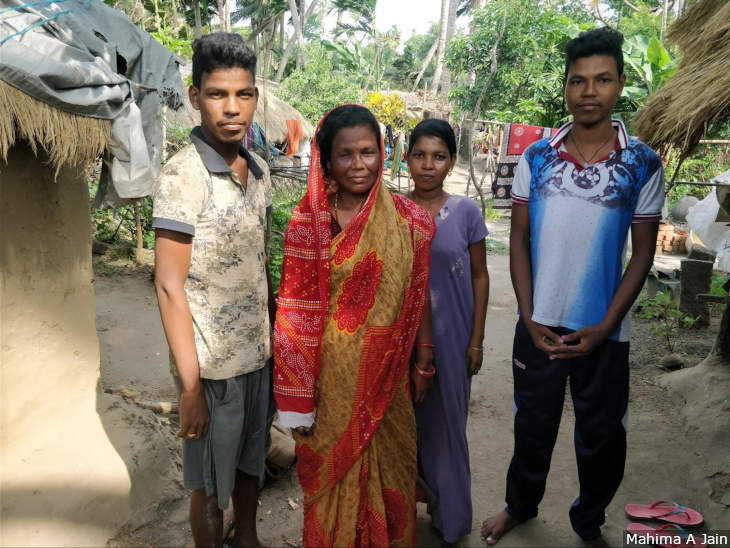
Pratima Das (second, left) with her children Pralay, Lipika and Kuber. Pratima was just 25 when the 1999 Super Cyclone submerged her parent’s house in Dhinkia. Her elder son Kuber works at a factory in Puducherry, which was affected by the 2018 Cyclone Gaja. Six months later, Pratima and her other two children were once again in the path of a cyclone, this time Fani.
Kuber, 22, Pratima Das’ eldest son, is one such migrant. While the family has a permanent house now, their farm is in a flood-prone, low-lying coastal area. It is also facing the possibility of a corporate takeover. With no local sources of income, Kuber travelled over 1,400 km south along the east coast in search of a job--to Puducherry, equally susceptible to Bay of Bengal storms.
When Gaja ripped through Puducherry, he was sharing a shack tacked together using plastic sheets with fellow migrants. They weren’t moved to a relief shelter, and weren’t aware of where one was in the city. The IIHS noted similar cases in Odisha, post-Fani.
When he returned to Govindpur in June, Fani had damaged Kuber’s family farmland. In September, he still hadn’t returned to the factory in Puducherry because of poor health. The Das’ only source of steady income has dried up. They have now joined the millions of Indians moving from one precarious job to another in a life shaped by disasters, climate change and economic uncertainties.
Reporting for this story was supported by Internews’ Earth Journalism Network.
(Jain is a freelance writer and editor based in Bengaluru. She tweets at @theplainjain)
We welcome feedback. Please write to respond@indiaspend.org. We reserve the right to edit responses for language and grammar.


